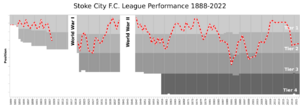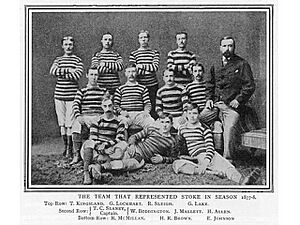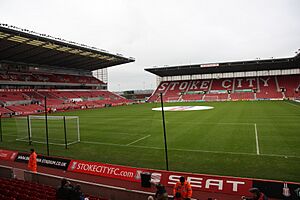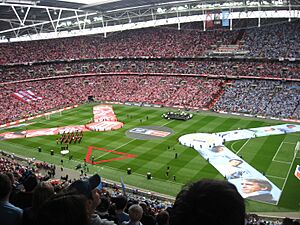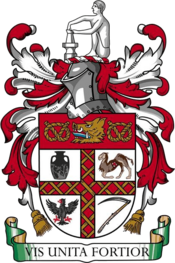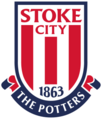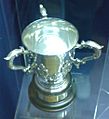Stoke City F.C. facts for kids
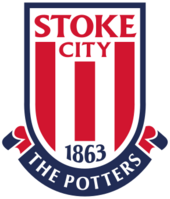 |
|||
| Full name | Stoke City Football Club | ||
|---|---|---|---|
| Nickname(s) | The Potters | ||
| Founded | 1863 1868 (first recorded match) as Stoke Ramblers F.C. |
||
| Ground | bet365 Stadium | ||
| Capacity | 30,089 | ||
| Owner | Stoke City Holdings Limited | ||
| Chairman | John Coates | ||
| Manager | Mark Robins | ||
| League | Championship | ||
| 2018–19 | Championship, 16th of 24 | ||
|
|
|||
Stoke City Football Club is a professional football team. They are based in Stoke-on-Trent, England. The team plays in the Championship, which is the second highest league in English football.
The club started as Stoke Ramblers in 1863. They changed their name to Stoke in 1878. In 1925, they became Stoke City after Stoke-on-Trent became a city. Their home stadium is the bet365 Stadium, which holds 30,089 fans. Before 1997, they played at the Victoria Ground since 1878. Stoke City's nickname is The Potters. This name comes from the pottery industry in their home city. Their traditional uniform is a red-and-white striped shirt, white shorts, and white socks. Their main rivals are West Bromwich Albion and Wolverhampton Wanderers. Their local rivals are Port Vale, and their matches are called the Potteries derby.
Stoke was one of the twelve original teams in the Football League when it began in 1888. They had some ups and downs in the early years. They were relegated from the top league in 1907. The club even went bankrupt in 1908 but was saved. They returned to the Football League in 1915. Stoke won the Third Division North in 1927 and the Second Division in 1933. They stayed in the top league for twenty years. Then, they spent ten years in the Second Division before winning promotion again in 1963.
Under manager Tony Waddington, Stoke won their first major trophy. They won the League Cup in 1972, beating Chelsea 2–1. They had also reached the final in 1964 but lost. Stoke played in the top league for fourteen years. They were promoted again in 1979. In 1990, they were relegated to the Third Division. Stoke won the Football League Trophy in 1992. They were promoted as champions in 1993. After another relegation in 1998, they won the Football League Trophy again in 2000. They earned promotion in 2002 by winning a play-off final. Manager Tony Pulis led Stoke into the Premier League in 2008. In 2011, they reached the FA Cup final but lost to Manchester City. This allowed them to play in a European competition. After ten years in the Premier League, Stoke was relegated to the EFL Championship in 2018.
Contents
- Club History
- How Stoke City Started (1863–1919)
- The Victoria Ground and Stanley Matthews (1919–1937)
- Challenges and Changes (1937–1960)
- The Tony Waddington Era (1960–1977)
- Many Managers (1977–1997)
- New Stadium and New Owners (1997–2008)
- Ten Years in the Premier League (2008–2018)
- Back in the Championship (2018–Present)
- Stadium History
- Stoke City Fans
- Rival Teams
- Team Kit and Crest
- Club Records
- Players
- Club Management
- Trophies and Achievements
- Images for kids
- See also
Club History
How Stoke City Started (1863–1919)
Stoke Ramblers club was formed in 1868 by Henry Almond. He was a student who loved playing football. Almond wanted to keep playing after moving to the area. So, he started the first official football club there. The club's first recorded game was in October 1868. Harry Almond was the captain and scored the first goal.
In 1870, the club changed its name to Stoke Football Club. They started playing at the Athletic Club ground, which became known as the Victoria Ground. Around this time, they began wearing their famous red-and-white striped uniform. In 1885, the club became professional.
Stoke was one of the twelve founding members of the Football League in 1888. They struggled at first, finishing last in their first two seasons. In 1890, Stoke was not re-elected to the league. They joined the Football Alliance and won it, which allowed them to rejoin the Football League. Stoke played in the top division for the next 15 seasons. They reached the FA Cup semi-final in 1899. In 1907, they were relegated and had money problems. Stoke went bankrupt in 1908. They played in non-league football until 1915. The Football League was then stopped for four years because of World War I. When football started again in 1919, Stoke was back in the league.
The Victoria Ground and Stanley Matthews (1919–1937)
In 1919, the club became the owners of the Victoria Ground. They built a new stand, increasing the stadium's capacity to 50,000. In 1925, Stoke-on-Trent became a city. Because of this, the club changed its name to Stoke City F.C.
The 1930s saw the arrival of the club's most famous player, Stanley Matthews. Matthews grew up nearby and joined the club as a young player. He played his first game in March 1932 at age 17. By the end of the 1930s, Matthews was a star for the England national team. He was one of the best players of his time. Stoke won promotion from the Second Division in 1933. Matthews scored his first goal for the club in a 3–1 win against local rivals Port Vale.
By 1934, many fans were coming to games, with over 23,000 on average. This allowed the manager, Tom Mather, to buy more players. Stoke was seen as one of the top teams in the country. In February 1937, they had their biggest league win ever, beating West Bromwich Albion 10–3. In April 1937, a record 51,373 fans watched them play Arsenal. Freddie Steele scored 33 league goals in the 1936–37 season, which is still a club record.
Challenges and Changes (1937–1960)
After World War II, a sad event happened on March 9, 1946. During a cup game against Bolton Wanderers, 33 fans died and 520 were hurt. This event is known as the Burnden Park disaster. In the 1946–47 season, Stoke almost won the league title. They needed to win their last game, but a 2–1 loss to Sheffield United meant Liverpool won instead. Stanley Matthews left the club in 1947 to join Blackpool.
Stoke was relegated from the top division in 1953. Bob McGrory resigned as manager after 17 years. Frank Taylor took over, hoping to get the team promoted. But after seven seasons in the Second Division without promotion, Taylor was fired.
The Tony Waddington Era (1960–1977)
Tony Waddington became manager in June 1960. He had been a coach at the club since 1952. Waddington brought back Stanley Matthews, who was 46 years old. Matthews' return helped Stoke finish eighth in 1962. The next season, 1963, Stoke won the Second Division and were promoted. In their first season back in the top league, 1964, Stoke celebrated 100 years as a club. They reached the 1964 Football League Cup final but lost to Leicester City.
Waddington liked to sign experienced players. Matthews played his last game for the club in February 1965, shortly after his 50th birthday. Gordon Banks, England's World Cup-winning goalkeeper from 1966, joined Stoke in 1967. Banks was considered the best goalkeeper in the world. He helped the club stay strong in the First Division.
Stoke won their first major trophy on March 4, 1972. They beat Chelsea 2–1 in the 1972 Football League Cup final at Wembley. Goals from Terry Conroy and George Eastham secured the win. To reach the final, Stoke played 11 games, including four tough matches in the semi-final against West Ham United. Stoke also did well in the FA Cup, reaching the semi-finals in 1971 and 1972. However, they lost to Arsenal both times. Stoke also played in the UEFA Cup in 1972 and 1974.
In January 1976, a storm damaged the roof of a stadium stand. The repairs cost a lot of money, causing financial problems for the club. Key players were sold to pay for the repairs. With a weaker team, Stoke was relegated in 1977. Waddington left the club in March 1977 after 17 years as manager.
Many Managers (1977–1997)
George Eastham took over as manager but left in January 1978. Alan Durban became the new manager. Durban helped Stoke get promoted to the First Division in 1979. He left in 1981 to manage Sunderland. Many managers came and went over the next years. Stoke was relegated to the third division of English football in 1990.
Lou Macari became manager in May 1991. He led the club to win the 1992 Football League Trophy. They beat Stockport County 1–0 at Wembley. The next season, 1993, Stoke was promoted from the third division. Macari left in 1993 but returned in 1994. Stoke finished fourth in 1996 but lost in the play-off semi-final. Macari left again after the 1997 season. His last game was the final league match at the Victoria Ground.
New Stadium and New Owners (1997–2008)
In 1997, Stoke moved to their new stadium, the Britannia Stadium. It cost £14.7 million and had 28,384 seats. Stoke struggled in their first season there and were relegated to the third division. Several managers tried to improve the team's fortunes.
In 1999, an Icelandic group called Stoke Holding bought 66% of the club. Stoke became the first English football club owned by Icelanders. They hired the club's first foreign manager, Guðjón Þórðarson. He helped Stoke win the Football League Trophy in 2000, beating Bristol City 2–1 at Wembley.
Guðjón led Stoke to promotion in 2002 after two previous play-off defeats. They beat Brentford 2–0 in the final at the Millennium Stadium. Despite the promotion, Guðjón was fired just five days later.
Steve Cotterill became manager but resigned after only four months. Tony Pulis was appointed in October 2002. Pulis kept Stoke from being relegated in his first season. However, he was fired in 2005 after disagreements with the club owners.
Dutch manager Johan Boskamp took over in 2005. He brought in many new players, but the team's results were mixed. Boskamp left in 2006 when former chairman Peter Coates bought the club. Coates chose Tony Pulis to return as manager in June 2006. Pulis led Stoke to an eighth-place finish in 2007.
Ten Years in the Premier League (2008–2018)
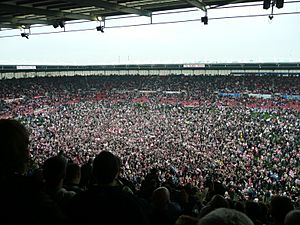
Stoke won automatic promotion to the Premier League in 2008, finishing second in the Championship. Many thought Stoke would be relegated quickly. But Stoke made their home stadium a "fortress," making it hard for other teams to win there. They beat teams like Aston Villa, Tottenham Hotspur, and Arsenal. Stoke finished 12th in their first Premier League season. They finished 11th in the 2009–10 season. Stoke also reached the FA Cup quarter-finals that year.
Stoke reached the FA Cup final for the first time in 2011. They had a famous 5–0 win against Bolton in the semi-final. However, they lost the final 1–0 to Manchester City. By reaching the final, Stoke qualified for the 2011–12 UEFA Europa League. In the Europa League, Stoke did well in their group. They then played against Spanish team Valencia but lost 2–0 over two games. Stoke signed Peter Crouch and continued to finish in mid-table in the Premier League. Tony Pulis left the club in May 2013.
Mark Hughes became the new manager in May 2013. He led Stoke to a ninth-place finish in 2014. This was their highest Premier League position. They finished ninth again in 2015 and 2016. Stoke's performance declined in 2017, finishing 13th. In January 2018, Hughes was fired. Paul Lambert took over, but he could not stop the club from being relegated to the EFL Championship. This ended their 10-year stay in the Premier League.
Back in the Championship (2018–Present)
After relegation, Gary Rowett became manager. Despite spending a lot of money on new players, the team's results were poor. Rowett was fired in January 2019. Nathan Jones replaced him. Stoke finished the 2018–19 season in 16th place.
Jones was fired in November 2019 after a slow start to the next season. Michael O'Neill became the new manager. Results improved under O'Neill, and the team avoided relegation. The 2020–21 season was played without fans because of the COVID-19 pandemic. Stoke finished in mid-table again. O'Neill was dismissed in August 2022. Alex Neil replaced him. Neil was unable to improve Stoke's mid-table position. He was replaced by Steven Schumacher in December 2023. Schumacher lasted less than a year and was also fired in September 2024. Narcís Pèlach was announced as the new manager on September 18, 2024, but was sacked in December 2024. Mark Robins was appointed as manager on January 1, 2025.
Stadium History
Stoke's first playing fields are not fully clear. They played at Sweetings Field starting in 1875. About 200–250 fans would attend matches there. In 1878, Stoke moved to the Victoria Ground.
The first game at the Victoria Ground was on March 28, 1878. Stoke won 1–0 against Talke Rangers. The ground was originally oval-shaped for athletics. Major changes began in the 1920s. By 1935, the stadium could hold 50,000 people. A record crowd of 51,380 watched a game against Arsenal on March 29, 1937.
Floodlights were added in 1956. In January 1976, strong winds blew off the roof of a stand. Stoke played a home game at Vale Park while repairs were done. More improvements were made in the 1980s. By 1995, Stoke planned to make the stadium all-seater. However, the club decided it was better to move to a new location.
In 1997, Stoke left the Victoria Ground after 119 years. They moved to the modern Britannia Stadium. In 2002, a record 28,218 fans attended an FA Cup match against Everton. When Stoke was promoted to the Premier League in 2008, more fans came to games. The stadium's name changed to the bet365 Stadium in June 2016. Work to expand the stadium to over 30,000 seats finished in summer 2017.
Stoke City Fans
Most Stoke City fans are from the local Stoke-on-Trent area. But there are also fan clubs in other places, like London, Scandinavia, Russia, Canada, the United States, and Australia. The stadium was often full when they played in the Premier League.
In the past, Stoke City had some problems with fan behavior. However, the club worked to improve this. They introduced schemes to encourage good behavior. Now, Stoke City fans and their stadium are known for being loud, friendly, and passionate. Famous people like Sugar Ray Leonard and Diego Maradona have visited. Many people admire the strong support of the club's loyal fans. Stoke offered free bus travel to every Premier League away game in the 2013–14 and 2014–15 seasons.
In November 2008, some Stoke fans were asked to leave Manchester by the police before a game. A human rights group helped them, and the police later apologized.
Stoke fans have sung "Delilah" as their anthem since the 1970s. Some of the song's words have been changed for the stadium. Stoke's official club anthem is "We'll be with you." The Stoke players recorded this song before the 1972 Football League Cup final.
Rival Teams
Stoke's local rivals are Port Vale. They are based in the Burslem area of Stoke-on-Trent. The two clubs have often been in different leagues. So, they have only played 46 league matches against each other. The last match was in 2002. The Potteries derby is usually a close game with few goals. Stoke has won 19 matches, and Port Vale has won 15.
Because they don't play Port Vale often, Stoke has other rivalries. These are with Midlands clubs like Derby County, West Bromwich Albion, and Wolverhampton Wanderers. A rivalry with Welsh team Cardiff City started in the 2001–02 season. They played each other in the Second Division play-offs.
Team Kit and Crest
Kit
Stoke's traditional uniform is red and white striped shirts with white shorts and socks. Their first uniform was navy and cardinal hoops. This changed to black and blue hoops. Then, the club decided on red and white stripes in 1883. However, in 1891, the Football League said only one club could use a certain style of uniform each season. Sunderland was allowed to use red and white stripes. So, from 1891 to 1908, Stoke used different uniforms, often plain maroon. In 1908, Stoke lost their League status and could go back to red and white. When they rejoined the league in 1919, the rule was removed. Since then, Stoke has always used red and white striped shirts. The only time they changed was for two seasons in the mid-1980s, when they wore a pin-striped shirt.
Crest
Stoke's first club crest was a fancy "S" used by players in 1882. In the 1950s, Stoke started using the shield from the Stoke-on-Trent coat-of-arms. This was used until 1977. A new, simpler club crest was then introduced. It had a Stafford knot and a pottery kiln, showing local traditions. Red and white stripes were also added. This crest was used until 1992. Then, the club decided to use the entire Stoke-on-Trent coat-of-arms. This included the club's name at the top. In 2001, they changed their crest to the current one. It includes their nickname "The Potters." For the 2012–13 season, they used a special crest for their 150th anniversary. It included the club's Latin motto "Vis Unita Fortior" ("United Strength is Stronger").
Sponsorship
|
|
|
Club Records
- Most Games Played: Eric Skeels – 592 games (league and cup).
- Most Goals Scored: John Ritchie – 176 goals (league and cup).
- Highest Transfer Fee Paid: £18.3 million for Giannelli Imbula from Porto (2016).
- Highest Transfer Fee Received: £20 million for Marko Arnautović to West Ham United (2017).
- Biggest Win Ever: 26–0 vs. Mow Cop (1877).
- Biggest League Win: 10–3 vs. West Bromwich Albion (1937).
- Biggest League Loss: 0–10 vs. Preston North End (1889).
- Biggest Premier League Win: 6–1 vs. Liverpool (2015).
- Biggest Premier League Loss: 0–7 vs. Chelsea (2010).
- Biggest FA Cup Win: 11–0 vs. Stourbridge (1914).
- Biggest FA Cup Loss: 0–8 vs. Wolverhampton Wanderers (1890).
- Biggest League Cup Win: 6–1 vs. Rotherham United (2023).
- Biggest League Cup Loss: 0–8 vs. Liverpool (2000).
- Record Attendance at Victoria Ground: 51,130 vs. Arsenal (1937).
- Record Attendance at bet365 Stadium: 30,022 vs. Everton (2018).
European Games
| Season | Competition | Round | Opponent | Home | Away | Aggregate |
|---|---|---|---|---|---|---|
| 1972–73 | UEFA Cup | First round | 3–1 | 0–4 | 3–5 | |
| 1974–75 | First round | 1–1 | 0–0 | 1–1 (A) | ||
| 2011–12 | UEFA Europa League | Third qualifying round | 1–0 | 1–0 | 2–0 | |
| Play–off round | 4–1 | 1–0 | 5–1 | |||
| Group E | 2–1 | 1–3 | 2nd | |||
| 1–1 | 1–1 | |||||
| 3–0 | 2–1 | |||||
| Round of 32 | 0–1 | 0–1 | 0–2 |
Players
First Team Squad
|
|
Players on Loan
|
Stoke City Women
Player of the Year
Club Management
Source:
- Board of Directors & Club Management
- Chairman: John Coates
- Vice-chairman & managing director: Richard Smith
- Director: Peter Coates
- Chief operating officer: Simon King
- Sporting director: Jonathan Walters
- First Team Management
- Manager: Mark Robins
- Assistant manager: Paul Nevin & James Rowberry
- First-team coach: Ryan Shawcross
- Goalkeeper coach: Darren Behcet
- Head of Performance: Joel Dawson
- Kit manager: Max Shapland
- Academy Staff
- Academy technical director: Gareth Owen
- Academy manager: Sam Stockley
- Stoke City Under-21s manager: David Hibbert
- Stoke City Under-21s assistant manager: Liam Lawrence
- Stoke City Under-18s manager: Dean Marney
Manager History
| Dates | Name | Notes |
|---|---|---|
| August 1874 – June 1883 | ||
| June 1883 – April 1884 | ||
| April 1884 – August 1890 | ||
| August 1890 – January 1892 | ||
| January 1892 – May 1895 | ||
| May 1895 – September 1897 | ||
| September 1897 – March 1908 | ||
| May 1908 – June 1914 | ||
| June 1914 – April 1915 | First manager not from England | |
| April 1915 – Feb 1919 | ||
| February 1919 – March 1923 | ||
| March 1923 – April 1923 | ||
| October 1923 – June 1935 | ||
| June 1935 – May 1952 | ||
| June 1952 – June 1960 | ||
| June 1960 – March 1977 | Most honours won as manager | |
| February 1977 – January 1978 | ||
| January 1978 | Caretaker manager | |
| February 1978 – June 1981 | ||
| June 1981 – December 1983 | ||
| December 1983 – April 1985 | ||
| April 1985 – May 1985 | Caretaker manager | |
| May 1985 – November 1989 | ||
| November 1989 – February 1991 | ||
| February 1991 – May 1991 | Caretaker manager | |
| May 1991 – October 1993 | ||
| November 1993 – September 1994 | ||
| September 1994 | Caretaker manager | |
| October 1994 – July 1997 | ||
| July 1997 – January 1998 | ||
| January 1998 – April 1998 | ||
| April 1998 – June 1998 | Caretaker manager | |
| June 1998 – June 1999 | ||
| July 1999 – November 1999 | ||
| November 1999 – May 2002 | First manager from outside the United Kingdom | |
| May 2002 – October 2002 | ||
| October 2002 – November 2002 | Caretaker manager | |
| November 2002 – June 2005 | ||
| June 2005 – May 2006 | ||
| June 2006 – May 2013 | First manager to reach the FA Cup final with Stoke | |
| May 2013 – January 2018 | ||
| January 2018 | Caretaker manager | |
| January 2018 – May 2018 | ||
| May 2018 – January 2019 | ||
| January 2019 – November 2019 | ||
| November 2019 | Caretaker manager | |
| November 2019 – August 2022 | ||
| August 2022 | Caretaker manager | |
| August 2022 – December 2023 | ||
| December 2023 | Caretaker manager | |
| December 2023 – September 2024 | ||
| September 2024 | Caretaker managers | |
| September 2024 – December 2024 | ||
| December 2024 – January 2025 | Caretaker manager | |
| January 2025 – |
Trophies and Achievements
Stoke City has won several trophies:
League Titles
- Second Division / Championship (Level 2)
- Champions: 1932–33, 1962–63
- Runners-up: 1921–22, 2007–08
- Promoted: 1978–79
- Third Division North / Second Division (Level 3)
- Champions: 1926–27, 1992–93
- Play-off winners: 2002
- Football Alliance
- Champions: 1890–91
- Birmingham & District League
- Champions: 1910–11
- Southern League Division Two
- Champions: 1909–10, 1914–15
- Runners-up: 1910–11
Cup Wins
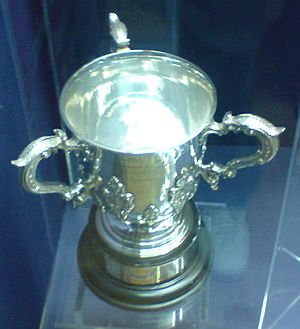
- FA Cup
- Runners-up: 2010–11
- League Cup
- Winners: 1971–72
- Runners-up: 1963–64
- Football League Trophy
- Winners: 1991–92, 1999–2000
- Watney Cup
- Winners: 1973
Other Trophies
- Staffordshire Senior Cup
- Winners (19): 1877–78, 1878–79, 1903–04, 1913–14, 1920–21, 1929–30, 1933–34, 1938–39, 1947–48, 1964–65, 1968–69, 1970–71, 1974–75, 1975–76, 1981–82, 1992–93, 1994–95, 1998–99, 2016–17
- Birmingham Senior Cup
- Winners: 1901, 1914
- Isle of Man Trophy
- Winners: 1987, 1991, 1992
Images for kids
See also
 In Spanish: Stoke City Football Club para niños
In Spanish: Stoke City Football Club para niños


